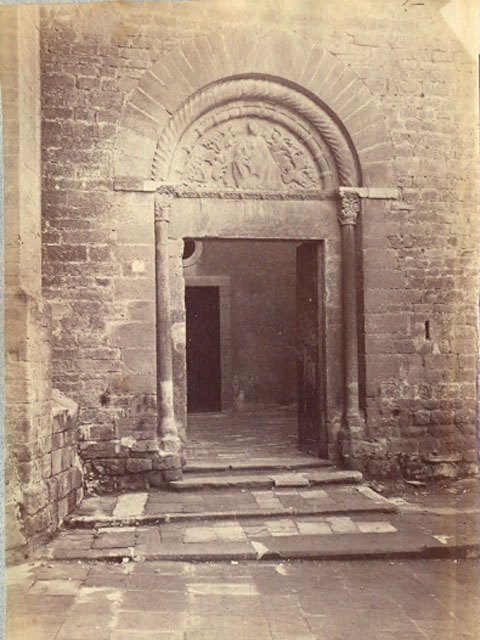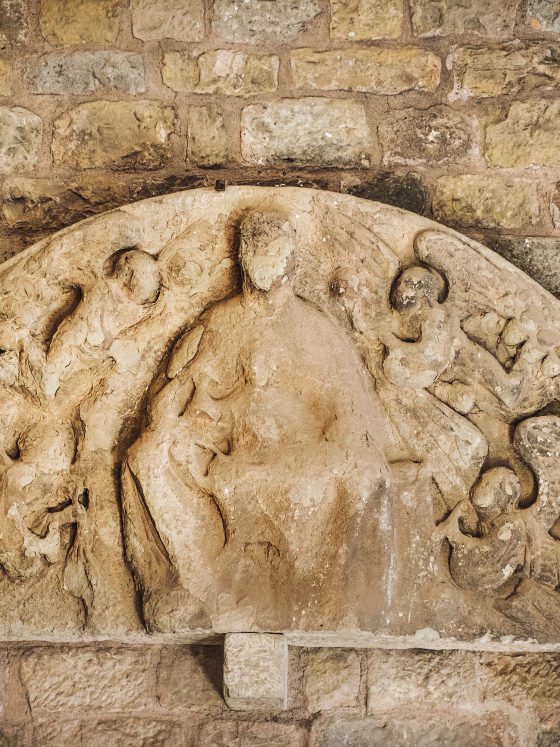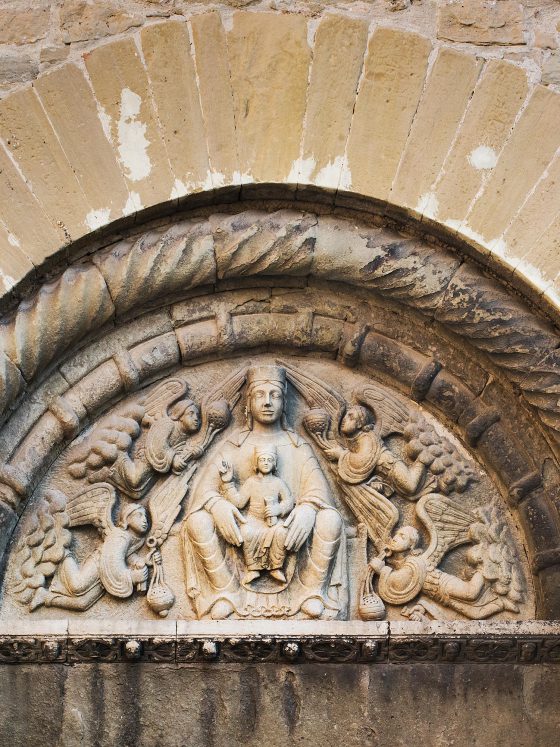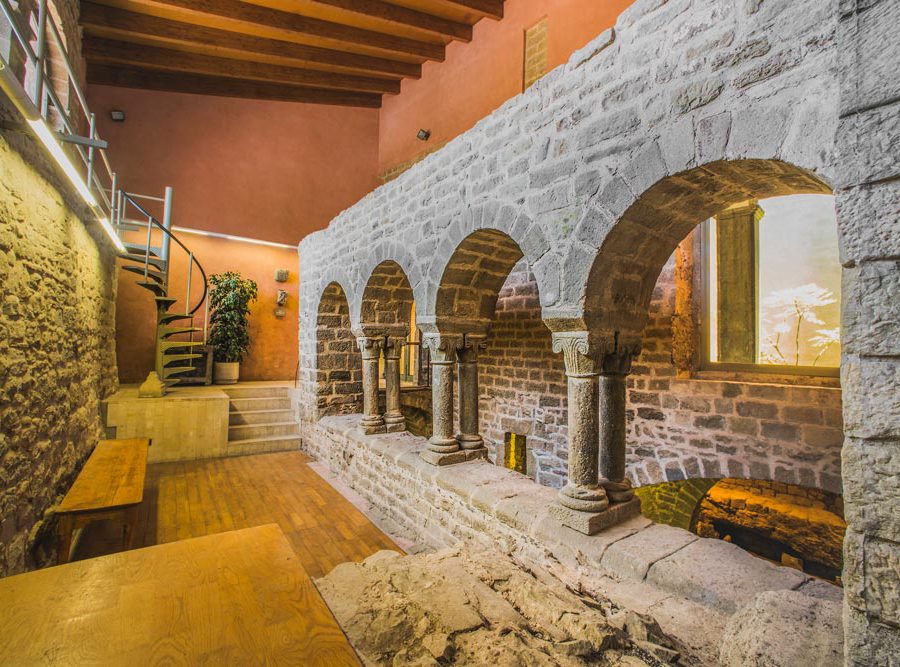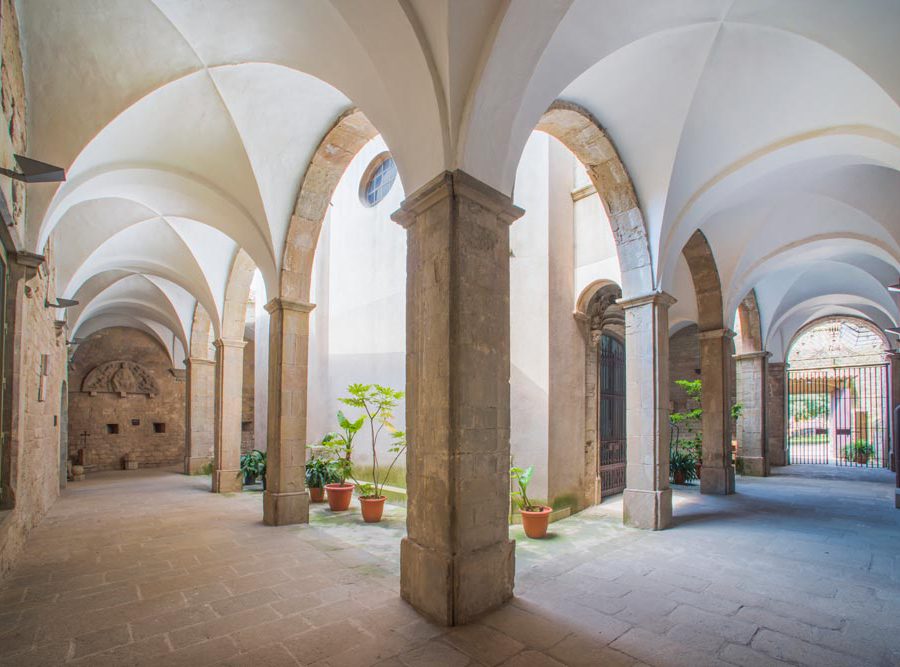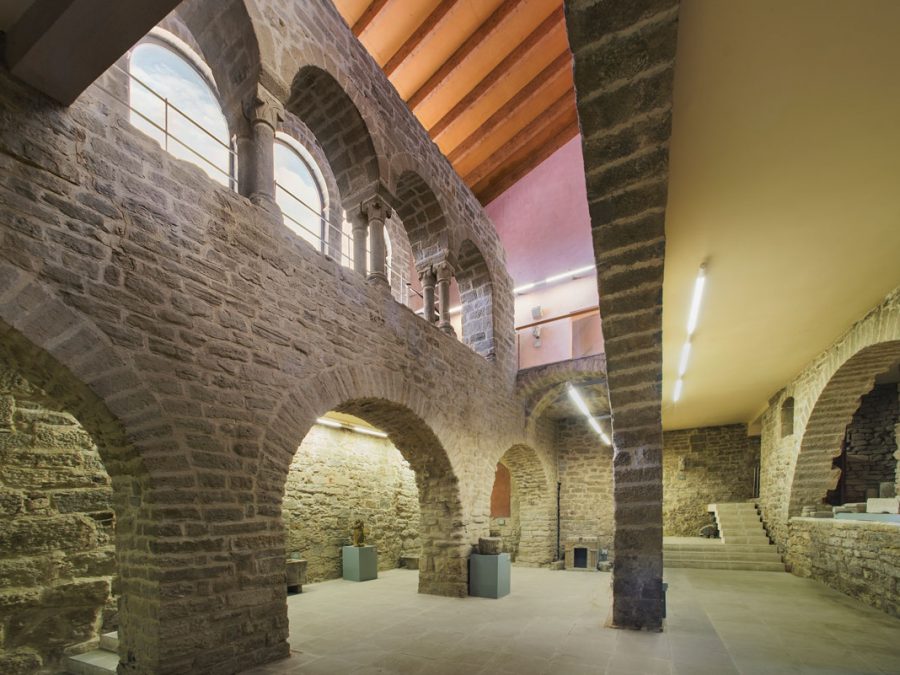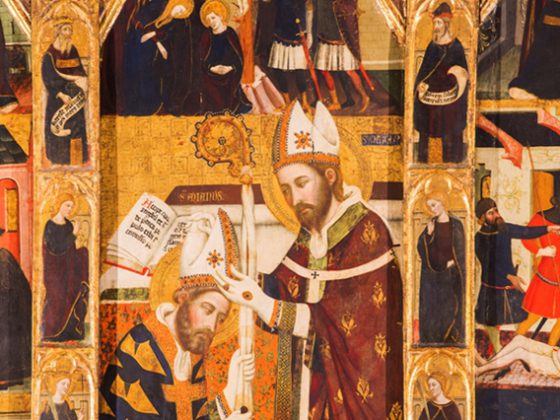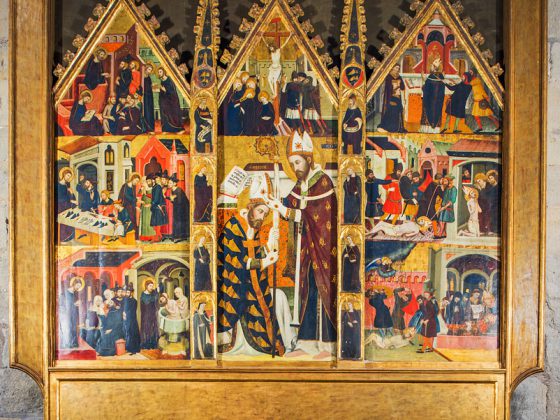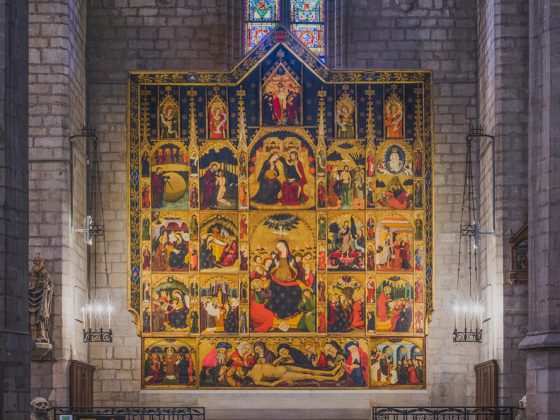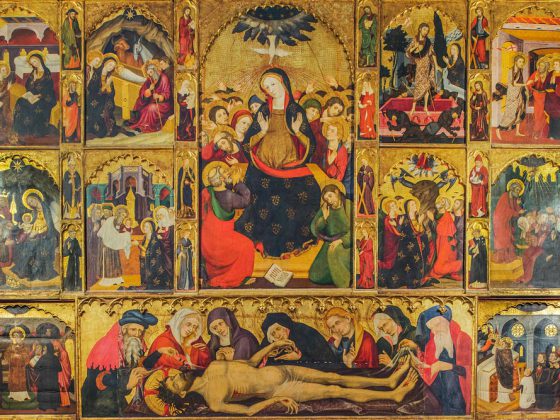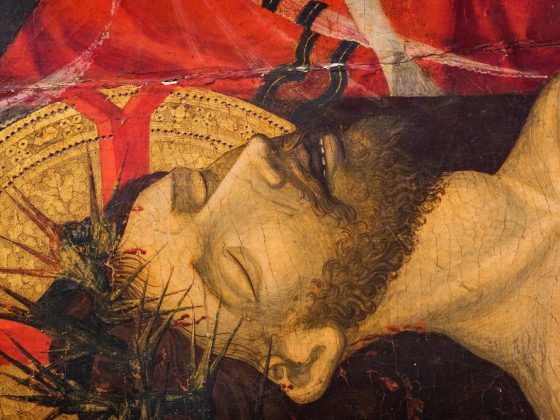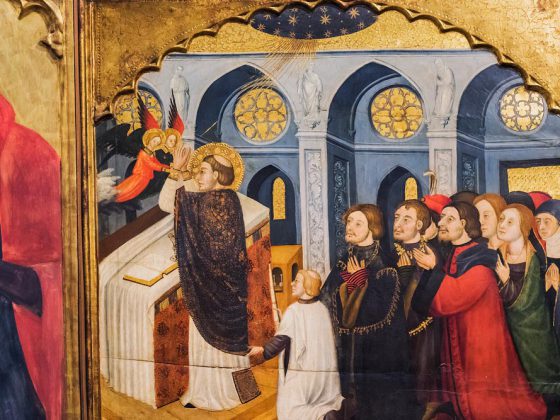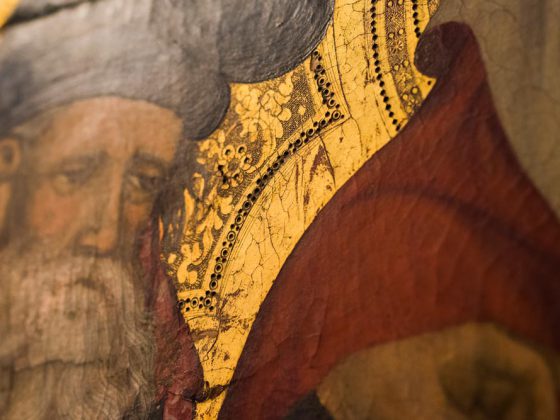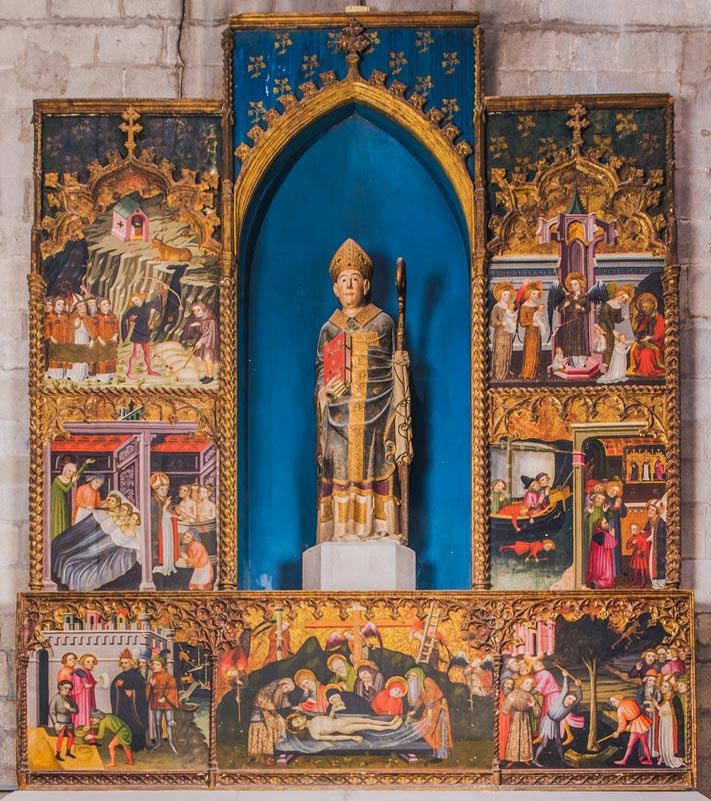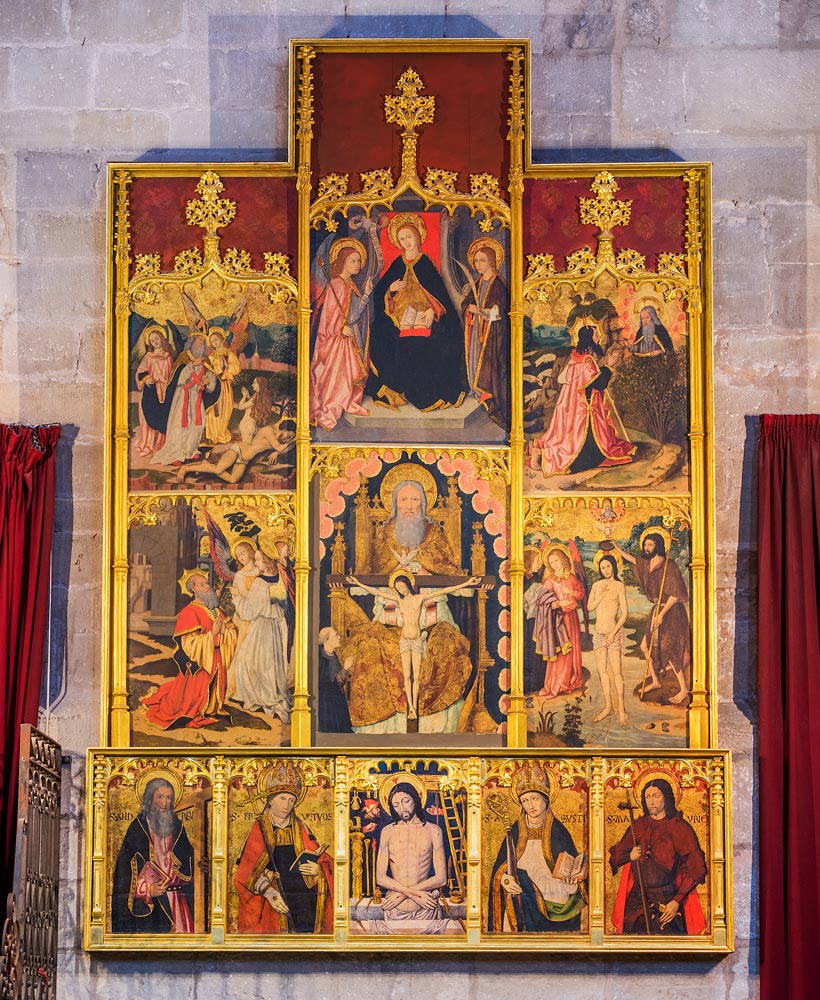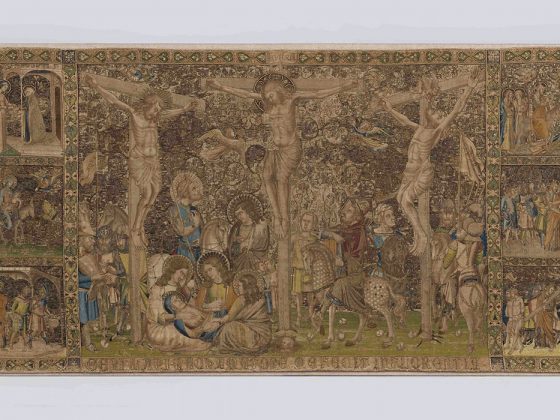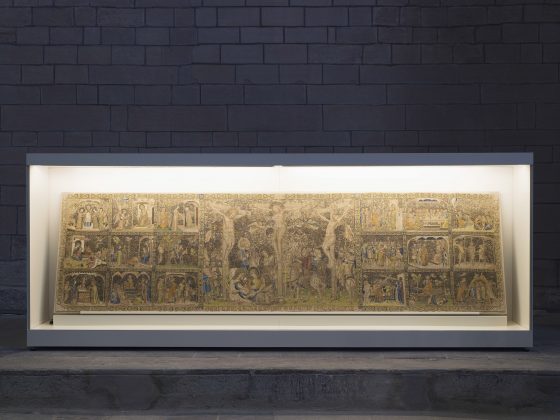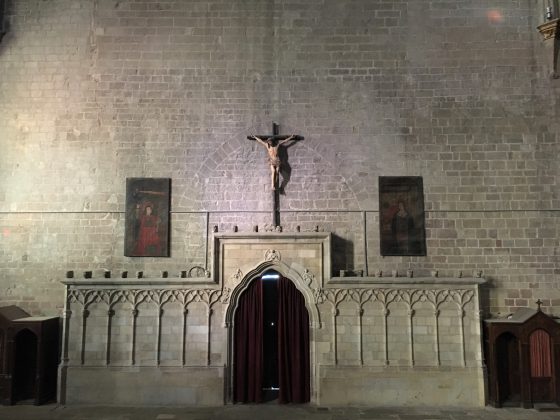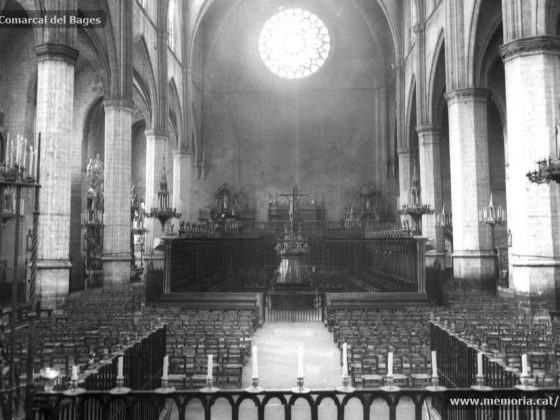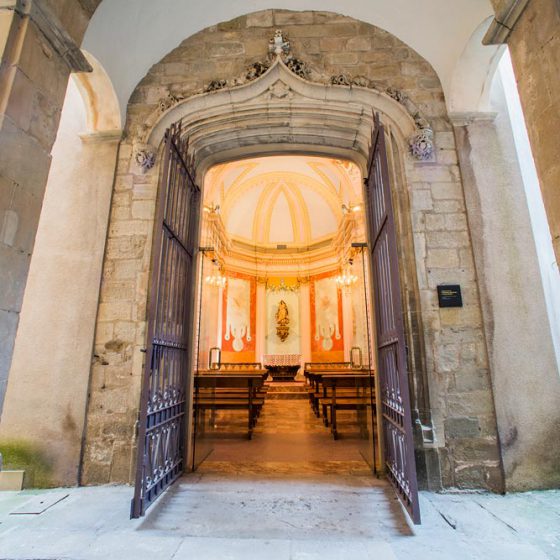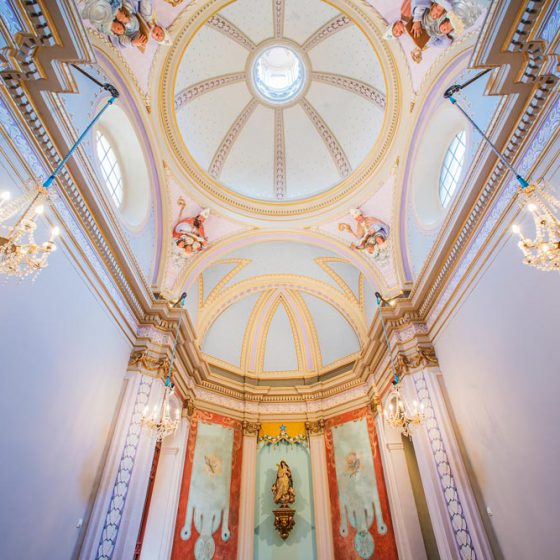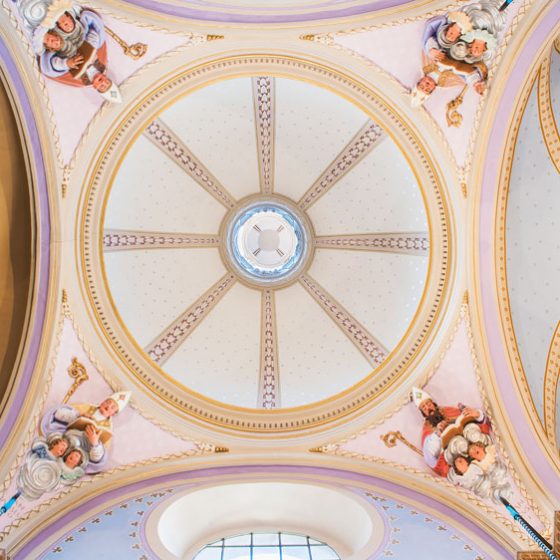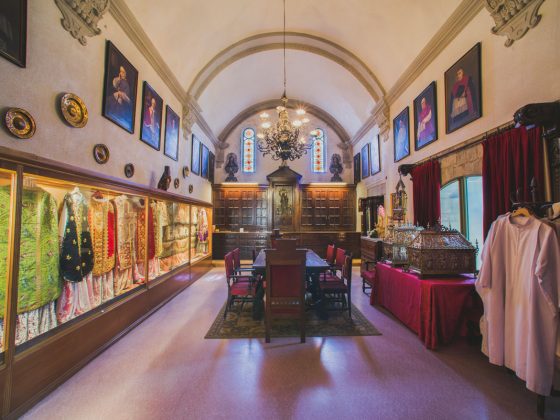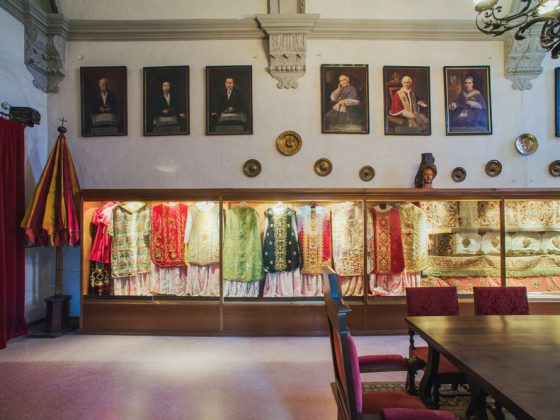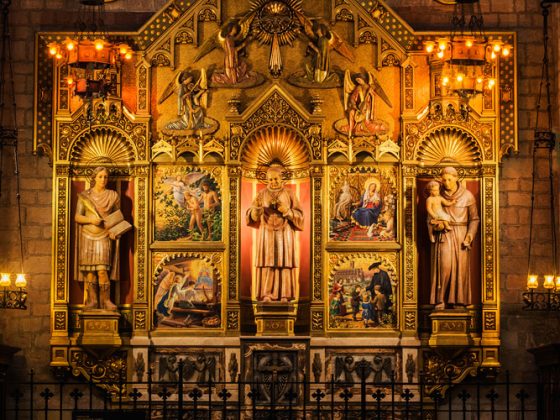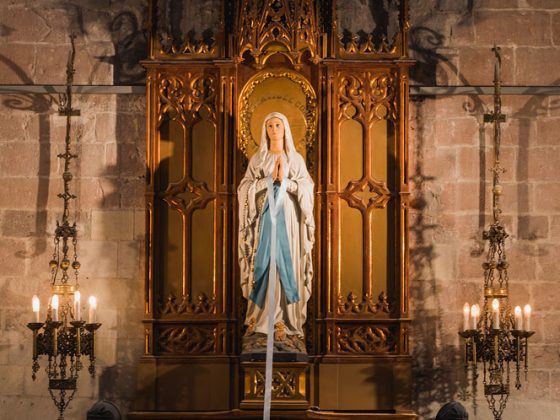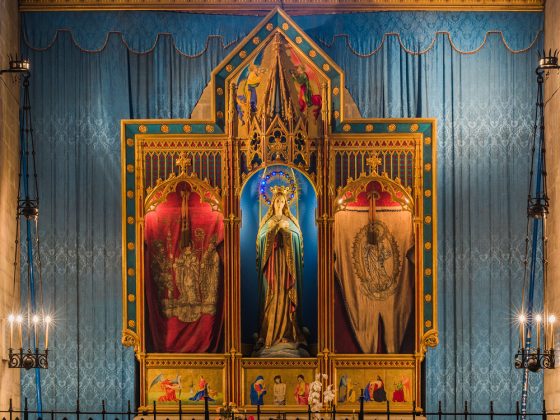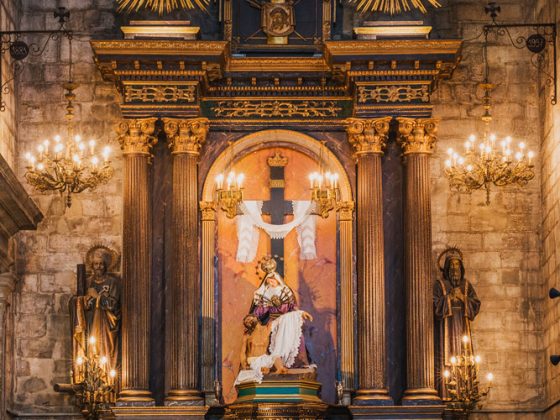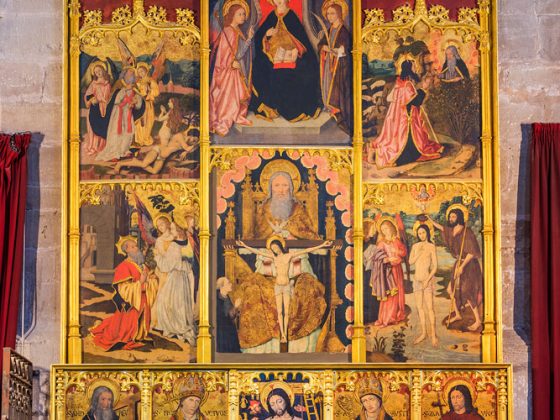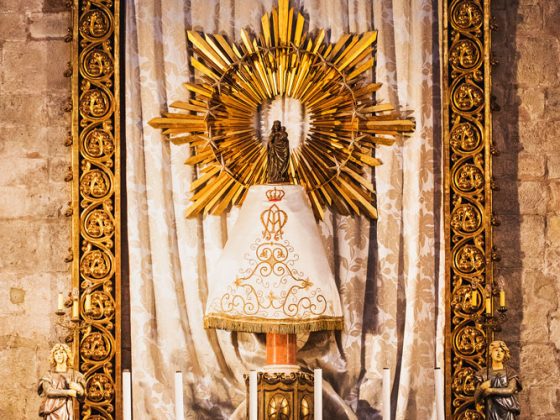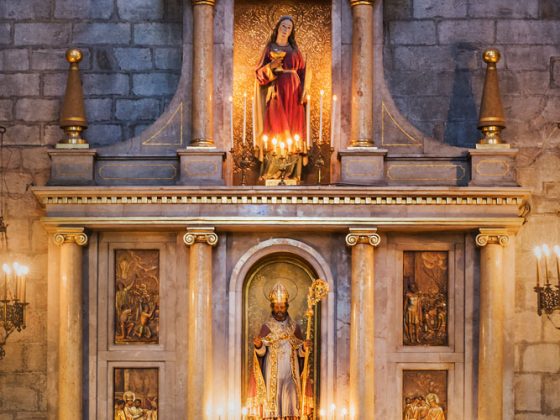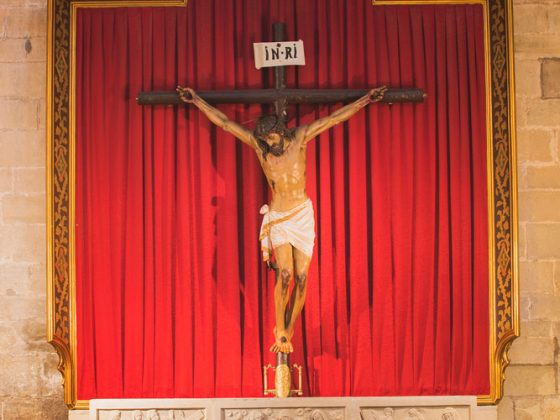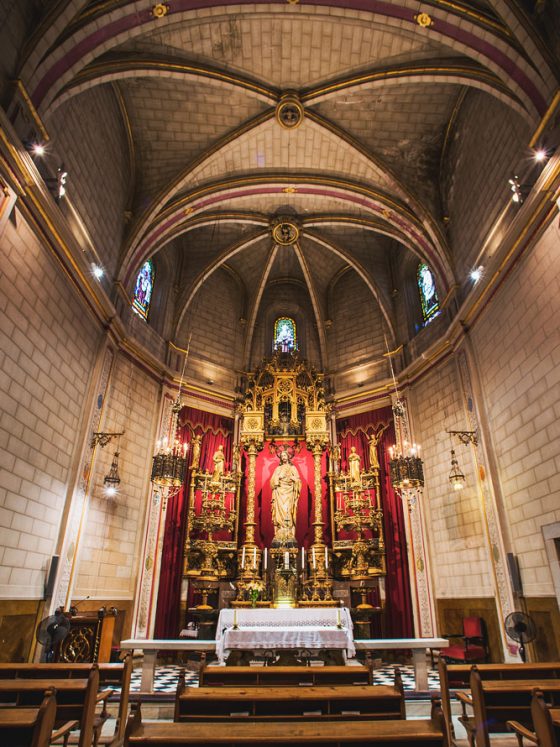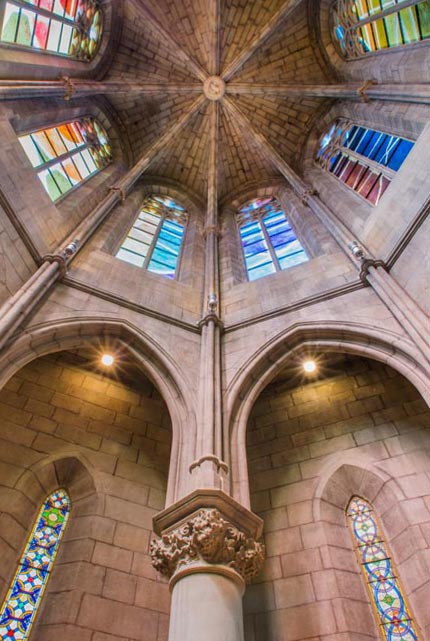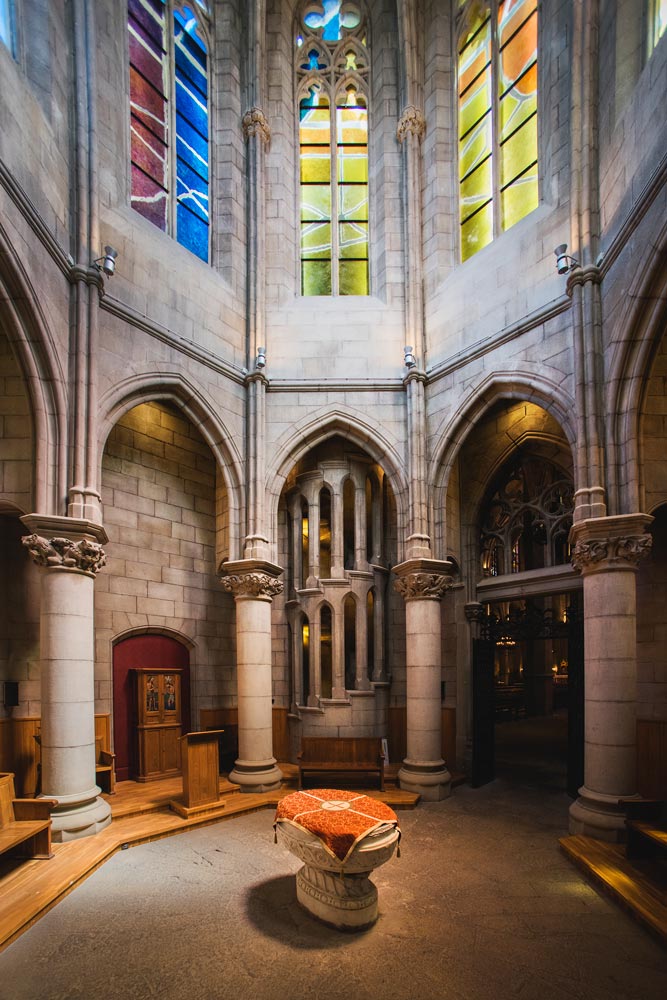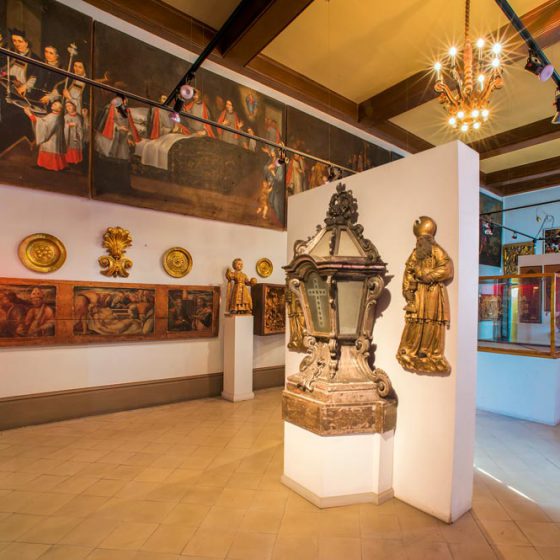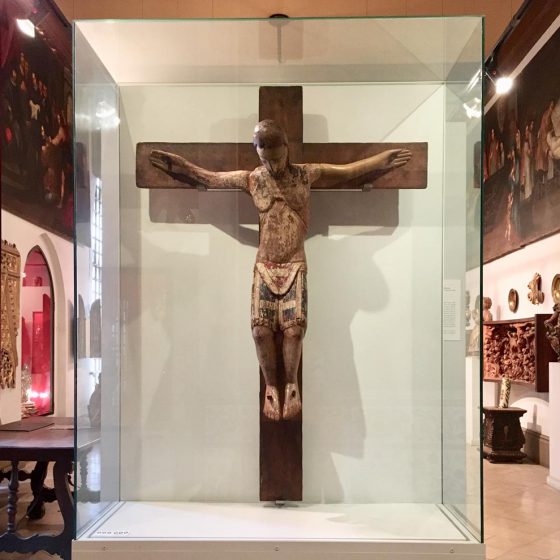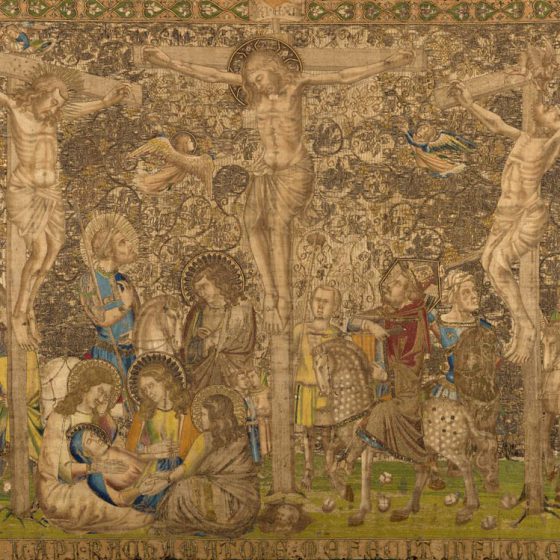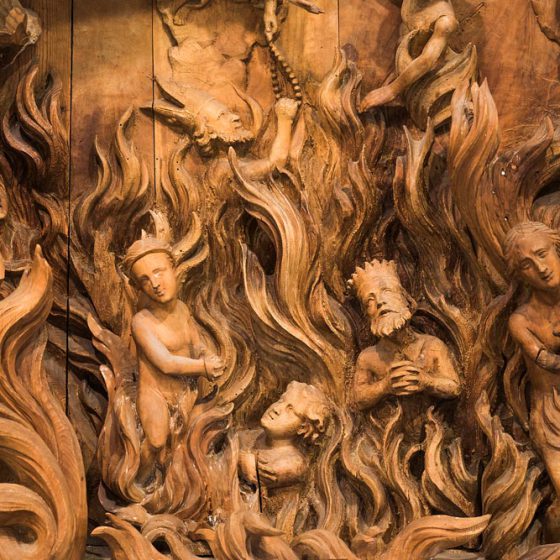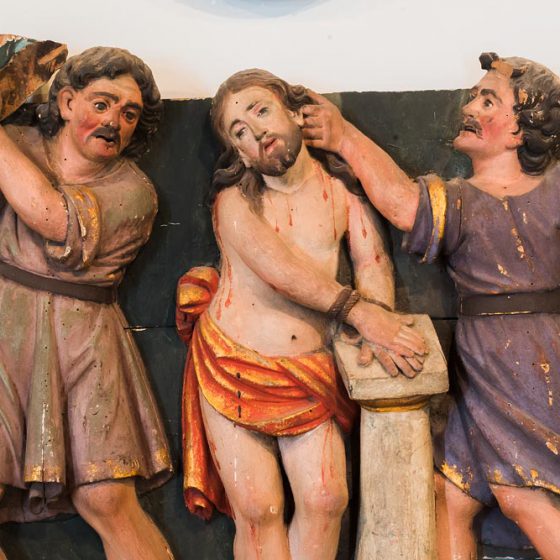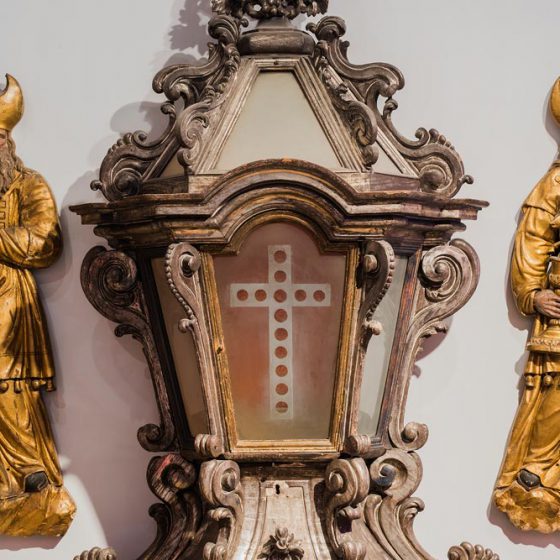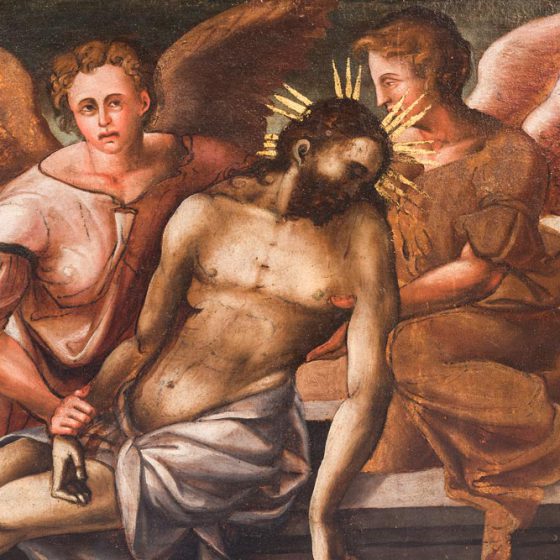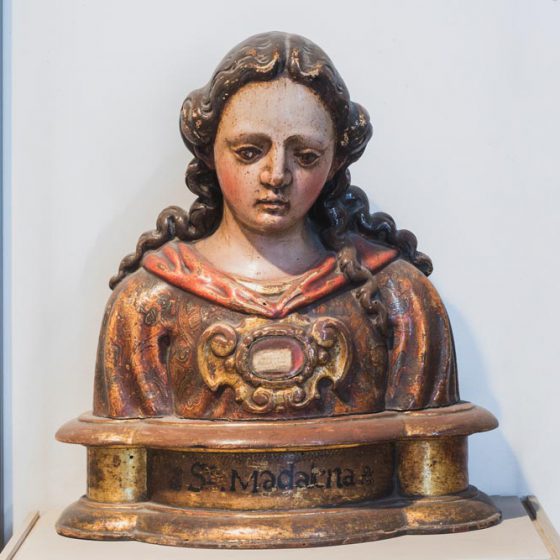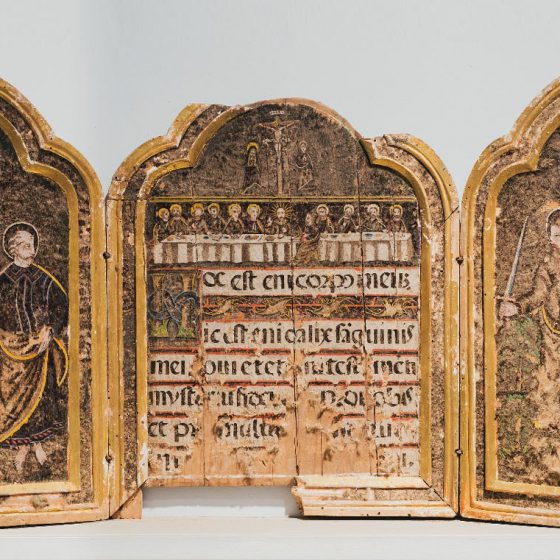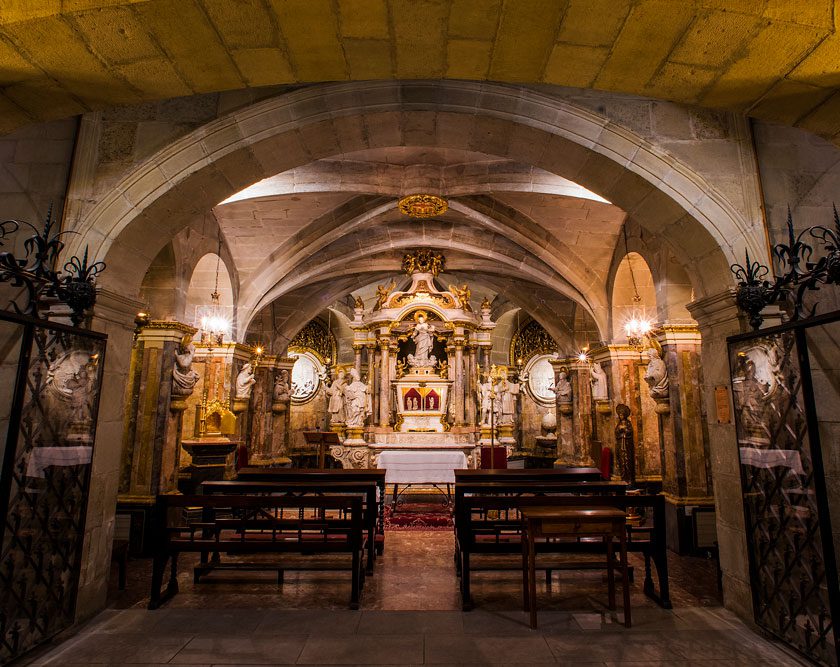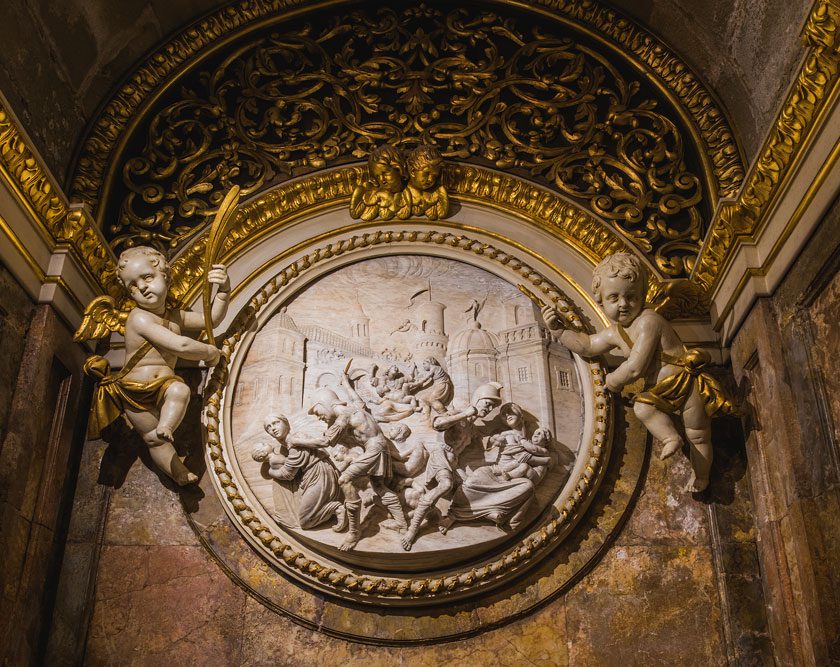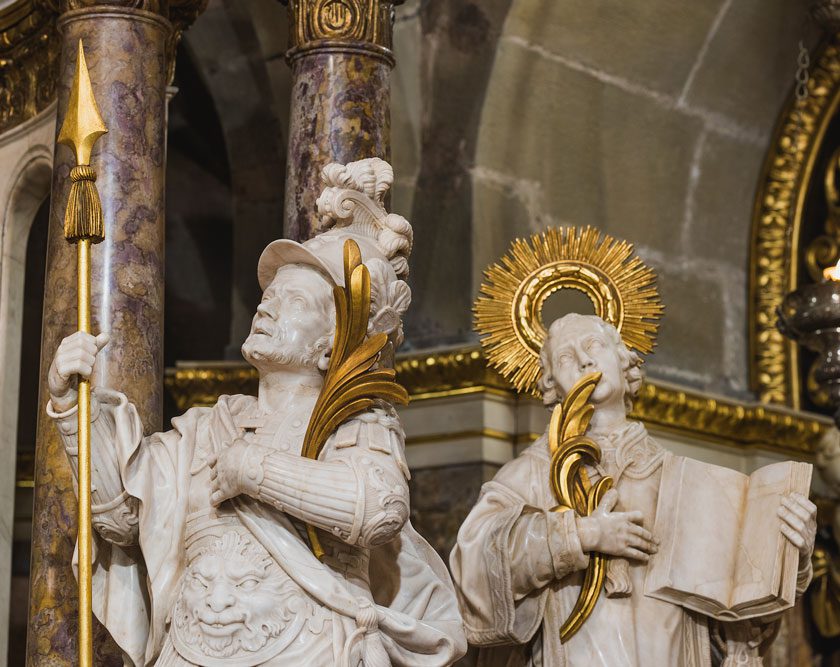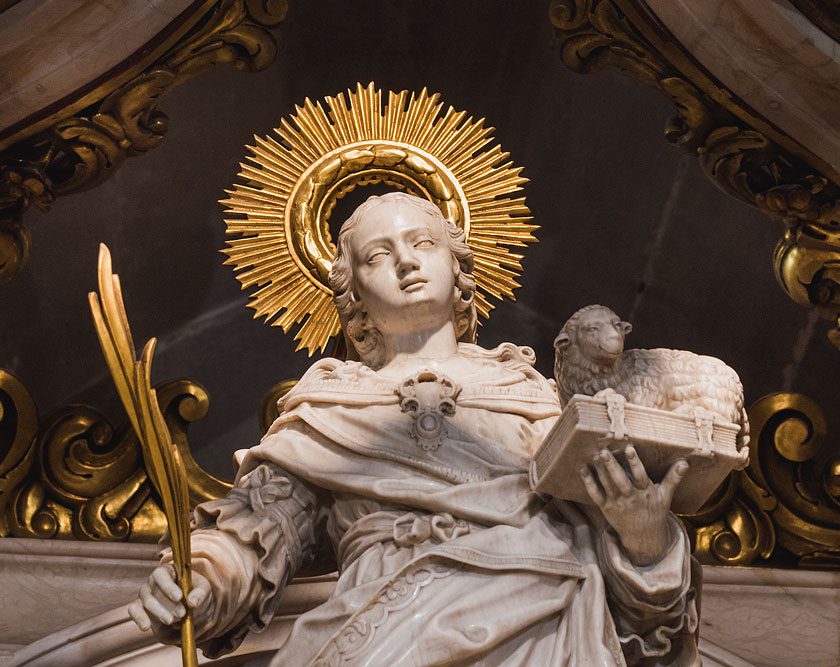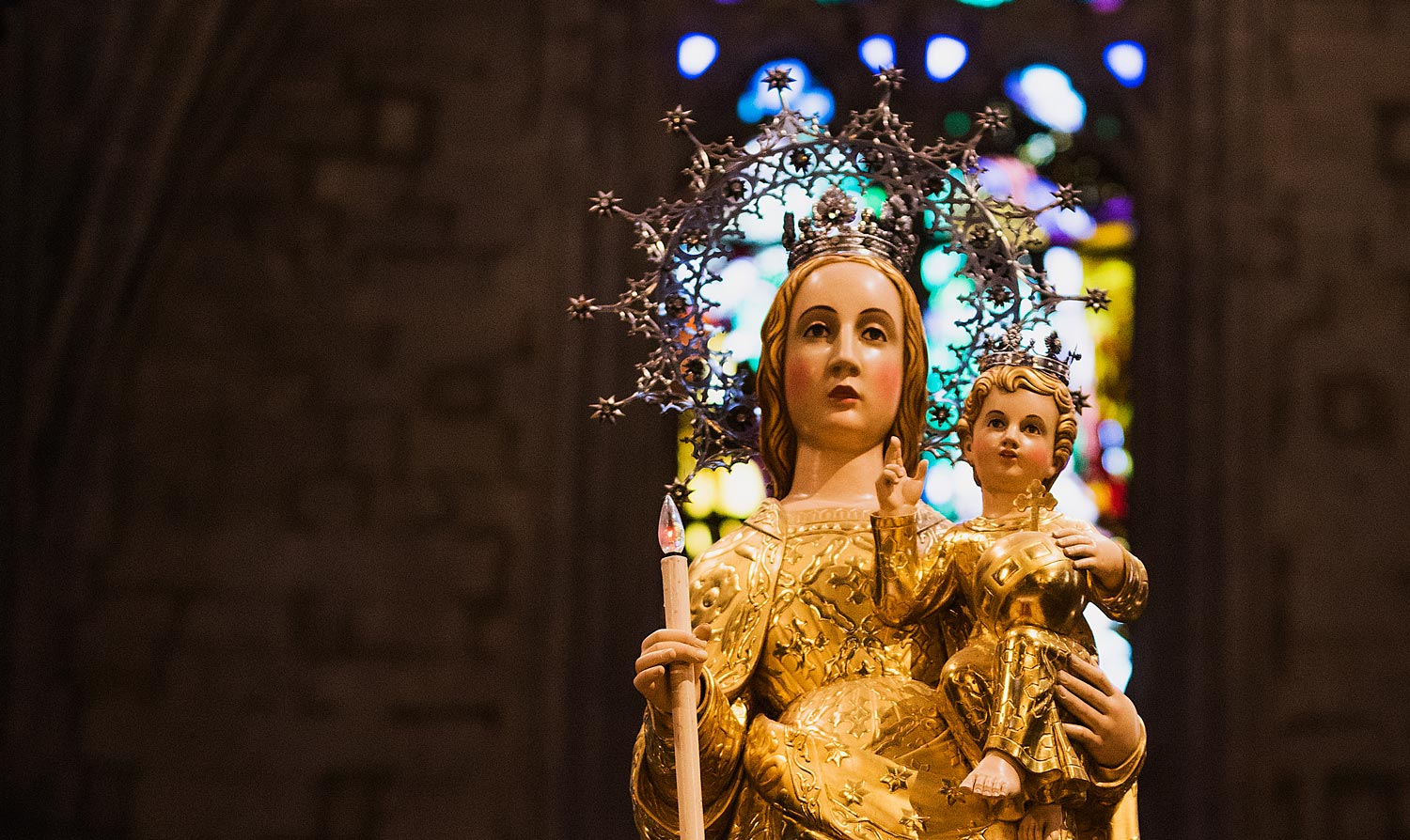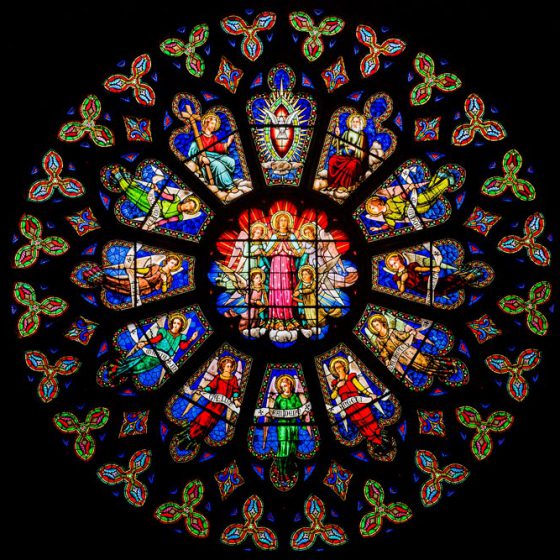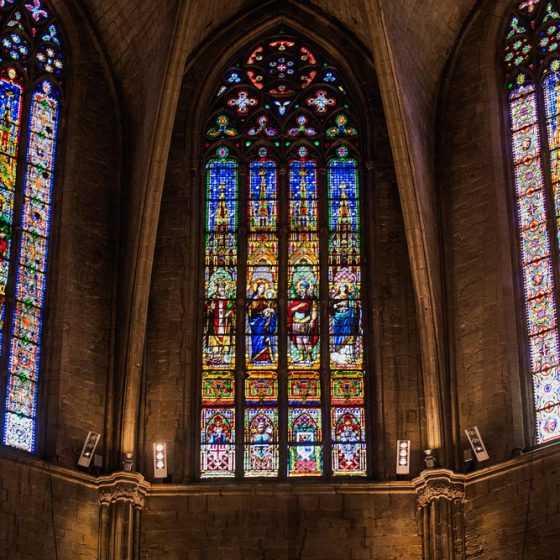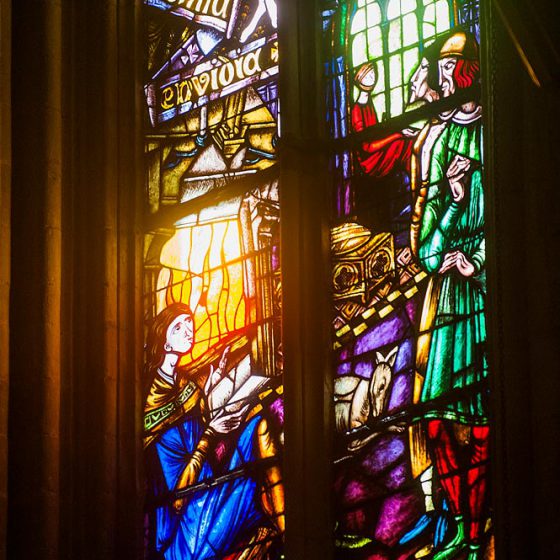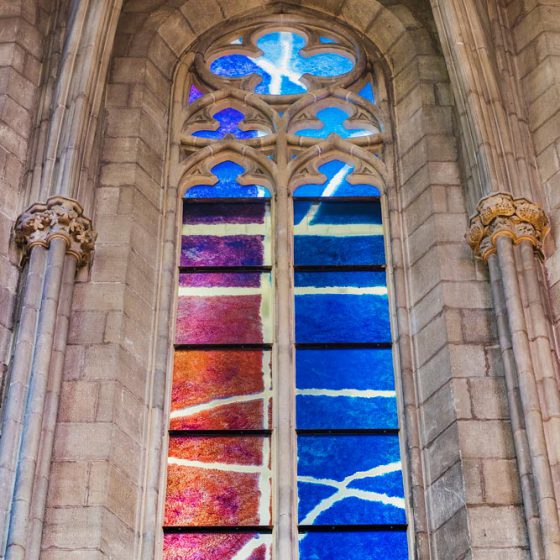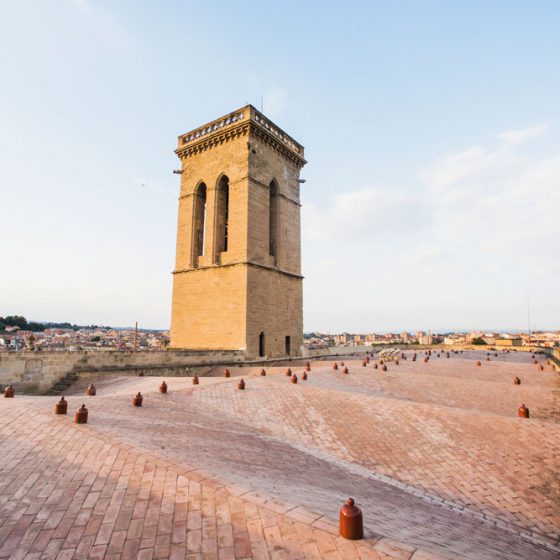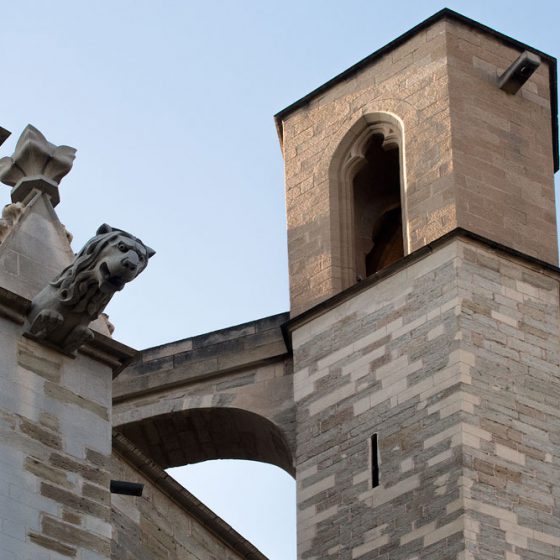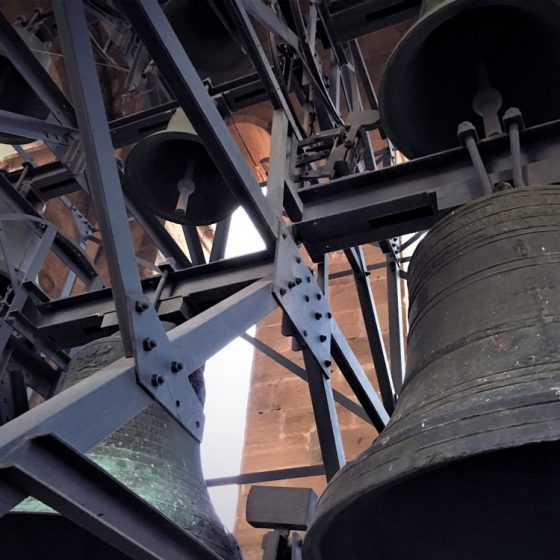Art heritage
The heritage elements of the basilica are innumerable and of all kinds: cloisters, chapels, altarpieces, stained glass windows … the most outstanding are explained below.
The romanesque front
The sculpted elements of what probably was the main front are the vestige of the Romanesque church that preceded the current Gothic building. Today these are located at the façade next to the cloister, at the Seu’s north face, next to the Saint Mary’s door. The front consists of two decorated archivolts that lay over two columns with chronicled capitals and a sculpted frieze along them.
The tympanum, with the Mother of God, Jesus and several angels is a reproduction of the original one which, nowadays is preserved in one of the cloister galleries.
Espai Oliba i claustre
Espai Oliba
Although both the city and the church of Manresa are already mentioned in documents from the ninth century, we must go back to the year 1020 in order to discover the origin of what they are today. After almost two decades of the destruction of the city, on July 15th of that year Countess Ermessenda and Bishop Oliba restored the parish boundaries and possessions of Santa Maria of Manresa, including a series of nearby churches. In this way, they provided the means for the maintenance of a community of canons and, later, for the construction of a new Romanesque church next to the castle of Puig Cardener. The town eventually grew up around it.
Popularly known as the “Romanesque cloister of the Seu”, this area contains important evidence of the recovery which began a thousand years ago. The four large semi-circular arches on the lower level, made of small ashlars, may well date from the same eleventh century. The four upper arches are smaller but more elaborate, with larger, well-squared ashlars, pairs of columns, and capitals carved with simple vegetal motifs. They were probably built in the twelfth century and indicate that the floor level of the Romanesque church and canonry was very similar to its level today.
On the 15th of July 2020, the basilica opened “Espai Oliba” to visitors to celebrate the Millenium of the visit of Bishop Oliba and Countess Ermessenda.
The cloister
The neoclassical cloister, located in an upper level, is from the 18th century. Four galleries with semicircular archs built on pillars and stone corbels compose it. The doorway, crowned by an ogee arch, is very interesting.In this area there are several and notable pieces of art such as the original tympanum of the Romanesque front.
Gothic altarpieces
The group of four Gothic altarpieces makes up one of the most interesting groups of this style in Catalonia: the ones of Saint Mark and Saint Anian; the Holy Spirit; Saint Nicholas; and the Trinity.
The other Gothic altarpieces have been lost over the years; some parts of the saved ones are preserved at the Vic Episcopal Museum. The rest of the altarpieces are due to replacement works and further initiatives.
Altarpiece of Saint Mark
The Saint Mark altarpiece was initially commissioned to the painter Arnau Bassa (1346) by the Shoemakers Corporation in order to place it in a chapel in Barcelona’s cathedral. When it was substituted, the altarpiece ended up in Saint Mark’s chapel (Manresa) and in 1902 was transferred to the Seu.
The altarpiece presents, in a triptych format, several episodes of the Saint’s life since his conversion into Christianity until his torment and death. The presence of symbological images referring to the Shoemakers Corporation is constant, especially obvious in the chasuble of Saint Mark, invested bishop by Saint Anian.
The Holy Spirit altarpiece
The most outstanding altarpiece of the basilica is the one of the Holy Spirit by Pere Serra (1394), one of the greatest Catalan painters of the time. The central theme is the arrival of the Holy Spirit and was commissioned by the Guild of Quireters. All the scenes refer to the divine manifestation in twelve biblical episodes of culminating moments such as the creation of heaven and earth, the creation of Adam, the birth of Jesus, the baptism, death and resurrection, etc.
On the lower part, or predella, the central representation of the Holy Burial of Christ comes from another altarpiece (missing) dedicated to Saint Anthony, by Lluís Borrassà (1410).
Saint Nicholas altarpiece
Nicholas of Bari is the patron saint of the canons, clerics and doctors. These brotherhoods commissioned the altarpiece dedicated to Saint Nicholas, which shares prominence with Saint Michael. Its author, Jaume Cabrera, was commissioned in 1406 and in 1412 the work of art was already placed in the chapel. Not all the original altarpiece is preserved, but you can still see two episodes of the life of Saint Michael and several compartments related to the miracles of Saint Nicholas. In the center there is a 1960’s polychrome carving depicting a holy bishop. It is believed that earlier, in this space, there was a large-scale image of Saint Nicholas and Saint Michael.
The Trinity altarpiece
Antoni Marquès is the author of this altarpiece (1506 -1507). The image of the Trinity appears in the central compartment with a small image of Canon Bernat Massadella, kneeling, who is the one who commissioned the work personally. In the upper compartment there is the Virgin of Hope accompanied by archangel Gabriel and Saint Agnès, patron saint of Manresa. On both sides there are the Old Testament scenes (creation of Eve, Abraham’s encounter with the three angels and Moses and the burning bush), and the baptism of Jesus. There are four spaces on the predella (lower part) with Saint Andrew, Fruitós, Augustine and Maurice and in the centre there is a copy of the image of the Christ of Mercy (the original is in the Episcopal Museum of Vic). The vault of the chapel is also starred by the Trinity.
The Florentine front
The Florentine Frontal is an extraordinary 14th century embroidery made with silk threads, silver-gilt, on a double flat-bond canvas (taffeta). The preparatory drawing, which is also of an exceptional quality, can be seen in the areas where the embroidery has not been preserved. The work is signed – also with thread and needle – by the Florentine embroiderer Geri di Lapo, below the central scene of the crucifixion: “GERI LAPI RACHAMATORE ME FECIT IN FLORENTIA”. The pallium measures approximately 91 centimeters high by 333 centimeters wide and depicts three narrative scenes of the Infancy, Crucifixion and Passion of Christ.
Due to its brilliant execution and beauty, it is internationally considered one of the masterpieces of Florentine embroidery, the so-called opus florentinum.
In 2022, the work has been restored as part of the “Temps de Gòtic” programme, promoted by La Caixa Banking Foundation and the Department of Culture of the Generalitat de Catalunya. The restoration and adaptation of the chapel where it is currently exhibited has been carried out by the Generalitat’s Furniture Restoration Center and the Generalitat’s Architectural Heritage Service with the collaboration of the Bishopric of Vic.
Organ
The first organ of the Seu is documented in 1506. During the War of the Spanish Succession, in 1714, a fire burned the existing organ that was rebuilt, a few years later, by the organ masters Anton and José Boscá. The current organ was purchased in 1957 at the Montserrat Monastery (built in 1922), to replace the one that was burned on the 29th of April 1937 (during the Civil War). In 1988 Blancafort’s ampliation of registers and restoration were released.
The first organist of the Seu was Miquel Aymerich del Bosch, in 1562.
In 2020, a group of citizens presented the campaign ‘Let’s restore the organ of the heart of Catalonia’ with the aim of restoring the instrument. In the website of the campaign you will find all the information about the project.
The Seu’s music
The Music Chapel has been documented since 1611. It was directed by the chapel master who was responsible for chants and was a composer too. The first person who held the title of Chapel Master was the Rnt. Jaume Canyelles in 1625. The Music Chapel has an archive with works by the main Catalan composers of religious music from the 18th to the 20th century. The oldest surviving score is the Christmas Verbum caro, by the chapel master Josep Masvasí ,1733.
Nowadays, the Chapel collaborates with lots of parish masses and city events under the direction of Mireia Subirana.
The old choir
The choir was built in 1394 and is currently missing. It occupied the space of the central nave corresponding to the third and fourth sections, without touching the pillars. In that quadrangular space, the community practiced choral singing. Macià Bonafè and Pere Llagostera built the Gothic ashlar masonry between 1430 and 1442, which was burned in 1714. The closing stone wall and its ornamentation were made in full Gothic style by Alonso de Baena in 1489; It was destroyed in 1936 and only a beautiful collection of sculpted capitals remains. In 1715 a new choir was built, with carpentry carved by Josep Sunyer, which would disappear in 1936.
Nowadays, all the remainings of the choir are in the interior of the occidental wall of the Seu, framed by the atrium.
Favets chapel
Right in the central area of the cloister the Puríssima Concepció brotherhood built the so called “Favets Chapel” in a Neo-Classic style. Although it seems, in archeological terms, to have its origins in the 15th century, the current building is from the beginning of the 19th century.
It has a rectangular floor plan and polygonal apse, with a dome-relieved roof. During the excavation works of this zone an interesting stratigraphy of funerary kind from the first period of the Middle Ages until the 19th century was discovered.
Saint Agustine chapel
The canonical chapel is next to the basilica and the cloister and was buit between 1681 and 1683. It is Baroque and was probably built at the same time as the new cloister. It is accessible from the cloister and a sided way out to the Romanesque cloister.
It is a noble looking-like room that was recently musealized with paintings about the life of the canon Mulet and religious ornaments. At the entrance, on the floor, there is count Eck’s sepulchre, an officer of the emperor of Austria which defended Cardona in the 1711 siege.
Radiating chapels
Inside the basilica there are many radiating chapels located along the aisles and round the apse. Inside the apse there are seven chapels, five more on each aisle and facing the main façade there is the Holy Spirit’s chapel and the baptistery. Entering Saint Mary’s door and from left to right, the apse chapels are the Saint Christ, Mother of God of Montserrat, Saint Mark, Saint Peter (where the organ is), Saint Nicholas, Saint Joseph and the one of the Saera’s family. Almost all of them have altarpieces and altars.
On the left side of the nave, from the portal already mentioned to the back, the following chaples are located: Pilar, Saint Isidre, Saint Honorat, and the Holy Trinity and the Solitude. On the right side of the nave, the following chapels are located: the Holy Spirit, Saint Anthony M.Claret, Lurdes Virgin, the Immaculate and Saint Savior.
Holy Spirit chapel
It is a mid 17th century Renaissance style chapel with a ribbed vault. Previously, it had a splendid Baroque carving by Josep Sunyer (1715) that was destroyed during the Civil War (1936). The actual altarpiece is from Montserrat’s monastery and was brought to the basilica in 1957. This work of art was built in 1887 in a pre-modernist style and in the center there is a large image of the Sacred Heart of Jesus.
The vaulted keys of the chapel contain the shield of Manresa, the symbol of the pelican, and an image of Saint Thomas of Aquinas. The modern stained glass windows represent the images of the Virgin of the Sorrows, the Carmen and Saint Louis of Gonzaga, patronymic of the Sanpera’s family.
The forged iron door was originally located in the crypt. It was drawn by Alexandre Soler March and built by Manuel Masnou.
The baptistery
It is located at the right end of the main façade. The architect Alexandre Soler March, advised by Antoni Gaudí, built it in a Neo-Gothic style and it was inaugurated in 1921. It has an octagonal floor plan and a marble-worked baptismal font from the 17th century in the middle of the room.
Around it there is an ambulatory with eight cylindrical columns with capitals sculpted by Andreu Prunés. At the vault keystone there is a representation of the Holy Lamb. The door was drawn by Alexandre Soler March and the eight stained glasses are by Nídia Esquius (2008).
From the outside, the baptistery’s pyramidal shape becomes a characteristic image of the temple.
Historical Museum
The access to the Museum is through a spiral staircase that is next to the baptistery. The space was inaugurated in 1934 in order to conserve and exhibit works of sacred art that had been left out of use in everyday worship. Among the most important pieces are the Romanesque Christ of polychrome wood carving (12th century) and the Florentine front, an altar frontal unique in the world which is being restored right now.
The Museum also houses fragments of Baroque altarpieces by the famous Grau and Sunyer workshops in Manresa, an altarpiece dedicated to Saint Ponç (16th century), an image of the Immaculate (17th century) and several objects of goldsmithing and liturgical clothing.
The Museum can be opened under appointment.
The crypt
The crypt was built between 1576 and 1578 with a ribbed vault. Its original altarpiece (built between 1600 and 1602) was replaced in 1783 by a marble tabernacle, designed by the famous Manresa’s sculptor Jaume Padró Cots, along with eight baroque medallions with high reliefs that decorate the walls. The tabernacle was damaged in 1936 and was later on restored. In a huge display case it contains the relics of the “Holly Bodies” (Saint Agnès, Saint Fruitós and Saint Maurici) .
The crypt was broaden providing much more space for liturgical events. It is currently accessed via stairs on each side of the presbytery, but originally there was a central opening in the basilica nave to reach there.
The Alba Mother of God
The Alba Mother of God is the image that dominates the temple from the altar. The real scaled original Gothic sculpture was meaningfully burned in 1979. The current image is a copy of the Gothic one that reproduces it with fidelity, holding up a candle on her right hand, Jesus and the world in the left hand/arm and with her protectoral behaviour towards the inhabitants of Manresa.
It is told that Ignatius of Loyola, during his stay in Manresa, also devoted her during his stay in Manresa.
The Celebration Day takes place during the Assumption of Mary (15th August).
Stained glasses
The Seu has a large rose window on the main façade, a small one above the southern portal (known as the “Saint Anthony’s door”) and thirty polychrome historic stained glass windows that respond to three different building patterns.
Many of the stained-glass windows were lost in the fire of 1714, so many of the current ones are from the 19th century and others only from 50 years ago. The upper level of stained glasses corresponds to the central nave and the lower to the lateral chapels. They all let exterior light in and provide a great decorative elegance. The oldest are designs by Francesc Morell and Apel·les Mestres. Others, executed after the Spanish Civil War, are by Joan Vila. In the baptistery there is a contemporary work of stained glass (2008) by the artist Nídia Esquius.
Bell tower
The Seu’s tower bell was built between 1545 and 1592. It is one of the most distinctive elements of the monument and the city outlines. It was built above the Romanesque part of the temple at the north slope. At the 17th century the bells and the clock were embodied in. From the beginning of the 20th century and until 1936, the bell tower had a needle on its top that broke its gothic appearance.
Nowadays, the tower has on its upper part several apertures and is headed with a balustrade. There are eight bells, the oldest one was installed in 1522 and is called Saint Lucy.
The bell tower is 30 metres high and the access is through Saint Peter’s stair case.
The archive
The documental fund is kept in a room annexed to the Basilica. After several vicissitudes, destructions and transfers, what was left of the capitular archive could finally be collected in this storage room. The arrange work was done by Leonci Soler March towards the end of the 19th century was fundamental, as was Joaquim Sarret Arbós’s work, who followed Soler’s tasks.
Nowadays, the archive saves more than three hundred parchments, codex and notebooks, as well as more than a thousand and a half bundles, which come or were made, fundamentally, by the canopy, the community of beneficiaries or the region chief magistrate.
The archive opens every Saturday from 9.30am to 1.30pm.
